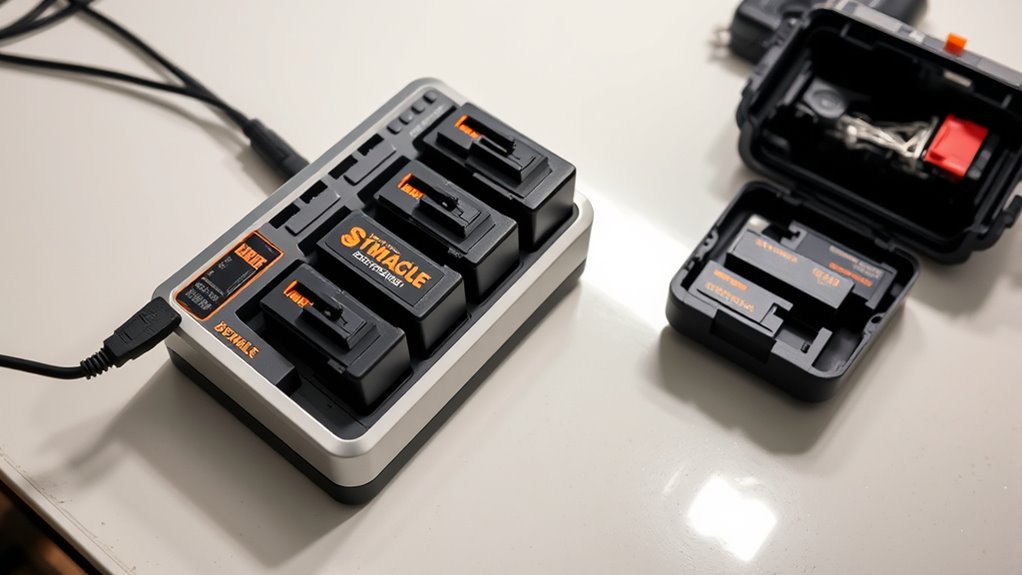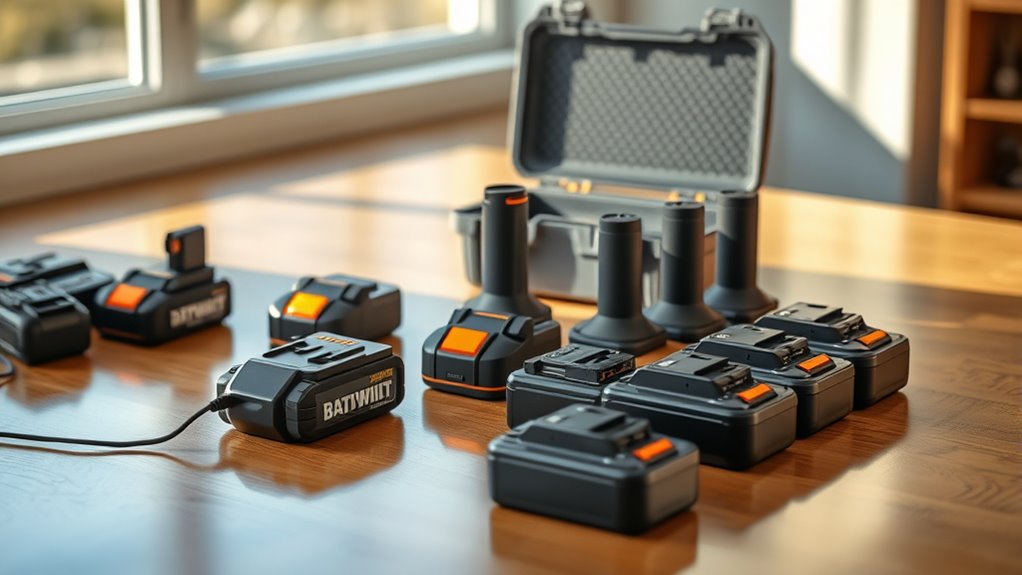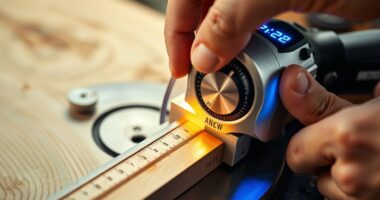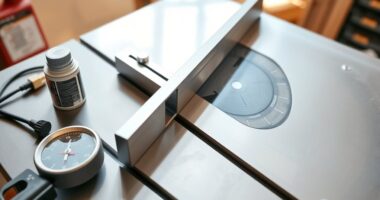To keep your cordless tool batteries in top shape, use the charger recommended by the manufacturer and avoid overcharging by unplugging once fully charged. Store batteries in a cool, dry place at about 40-60% charge, especially if you’re not using them for a while. Regularly check their health and look for signs of wear. Proper habits like these help extend battery life—continue exploring for more tips to boost performance.
Key Takeaways
- Use manufacturer-recommended chargers and unplug once batteries are fully charged to prevent overcharging.
- Store batteries in a cool, dry place at 40-60% charge for optimal longevity.
- Regularly monitor battery health to detect capacity decline and plan for replacements.
- Avoid exposing batteries to high heat or cold, which accelerates degradation or reduces performance.
- Dispose of used batteries responsibly at recycling centers or take-back programs to protect the environment.

Cordless tool batteries are essential components that power your portable tools, giving you the freedom to work without being tethered to a power outlet. To keep your tools running smoothly, understanding how to properly maintain these batteries is vital. Proper charging habits can substantially extend the battery lifespan, ensuring you get the most out of your investment. Always use the charger recommended by the manufacturer, and avoid overcharging or leaving the battery on charge for extended periods. Modern batteries often have built-in protections against overcharging, but it’s best to unplug once fully charged. Similarly, don’t let the battery completely drain before recharging. Keeping the battery in a partially charged state—around 40-60%—can help prolong its overall lifespan. If you notice that your battery isn’t holding a charge like it used to, it might be time to replace it rather than trying to squeeze more life out of an aging power source. Additionally, monitoring battery health regularly can help identify issues early and prevent unexpected failures.
Storage is another key aspect of maintaining your cordless tool batteries. When you’re not using your tools for an extended period, store the batteries in a cool, dry place away from direct sunlight and extreme temperatures. High heat can accelerate battery degradation, while cold environments can temporarily reduce performance. For long-term storage, it’s best to keep batteries at about 40-60% charge. Avoid storing batteries fully drained or fully charged for long durations, as both options can negatively impact their lifespan. Regularly check stored batteries to ensure they haven’t leaked or corroded, and recharge them if their charge drops below recommended levels. Proper storage practices not only extend your batteries’ life but also help prevent accidents or damage that might occur from corrosion or leaks.
When your batteries reach the end of their usable life, it’s essential to dispose of them properly. Batteries contain chemicals that can harm the environment if discarded improperly. Never throw old batteries in the trash; instead, take them to a designated recycling facility or return them to the manufacturer if they offer a take-back program. Many hardware stores and recycling centers accept used batteries, ensuring they’re processed safely and responsibly. Proper disposal helps prevent potential environmental contamination and supports recycling efforts to recover valuable materials. By following these simple maintenance and disposal tips, you’ll maximize your cordless tool batteries’ performance and lifespan, making your work more efficient and environmentally friendly.
Frequently Asked Questions
How Often Should I Calibrate My Cordless Tool Batteries?
You should calibrate your cordless tool batteries about once every three to six months to guarantee ideal calibration frequency. Regular calibration helps maintain battery accuracy, so you get reliable readings of charge and runtime. If you notice your battery’s performance declining or inaccurate power levels, calibrate it sooner. Consistent calibration keeps your tools performing effectively, preventing unexpected power loss and extending battery life.
Can I Use Non-Brand Chargers for My Cordless Batteries?
Coincidentally, using third-party chargers might seem convenient, but it’s risky because of battery compatibility issues. You can use non-brand chargers, but only if they’re specifically compatible with your cordless tool batteries. Otherwise, you could damage your batteries or reduce their lifespan. Always check the charger’s specifications and make sure they match your battery’s requirements. Sticking to original or certified third-party chargers helps keep your batteries safe and functioning properly.
What Are Signs of a Failing Cordless Tool Battery?
You’ll notice your cordless tool battery is failing if it holds a charge for less time, indicating reduced battery lifespan. Charging indicators may stay on or flicker, showing improper charging or internal issues. You might also experience slower tool performance or frequent power loss. If these signs appear, it’s time to contemplate replacing the battery to ensure your tools work efficiently and safely, preventing potential damage or injury.
How Do Temperature Changes Affect Battery Performance?
Imagine your battery as a delicate flower, sensitive to thermal effects. When temperatures rise or fall, it struggles to perform, just like a flower wilting in harsh weather. Extreme heat accelerates chemical reactions, draining power faster, while cold slows down electron flow, reducing capacity. Proper storage conditions shield your battery from these thermal effects, ensuring it stays healthy and ready to power your tools when you need them most.
Are There Environmentally Friendly Disposal Methods for Old Batteries?
You can practice eco-friendly disposal by recycling your old batteries through designated battery recycling programs. Many communities have collection centers or return programs that guarantee batteries are safely processed. Avoid throwing batteries in the trash, as harmful chemicals can leach into the environment. By choosing battery recycling, you help reduce waste and promote environmentally friendly disposal methods that protect our planet. Always check local guidelines for proper disposal options.
Conclusion
Taking good care of your cordless tool batteries is key to their longevity. Proper charging and storage can extend battery life considerably—up to 50% longer with the right habits. Did you know that many batteries lose about 20% of their capacity after just one year of improper storage? By following simple tips, you ensure your tools stay powerful and ready whenever you need them, saving you time and money in the long run.









